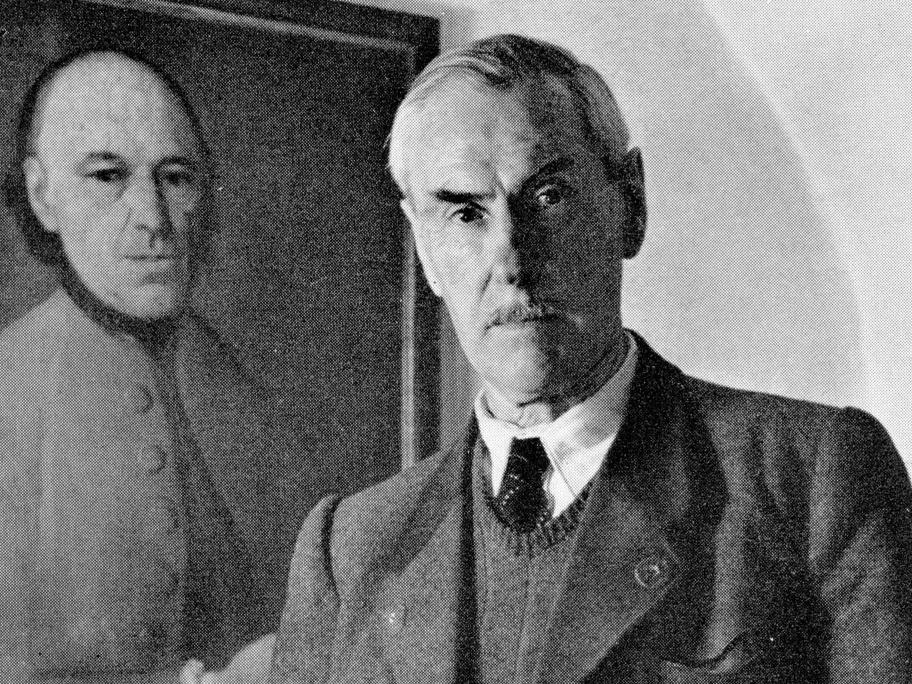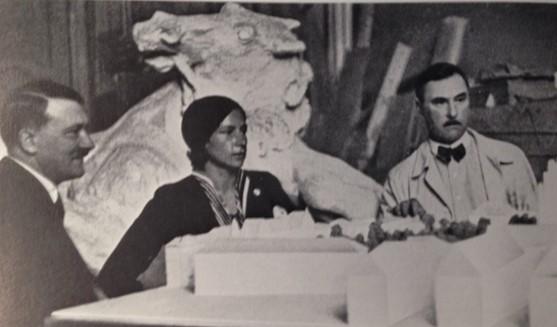From Faces of Ancient Europe

German sculptor Joseph Wackerle (1880–1959), the son of a builder, was born in Partenkirchen. He went to the Commercial Arts School and later to the Art Academy in Munich. Adolf von Hildebrand influenced Wackerle, just as he later influenced the sculptor Arno Breker. In 1904 Wackerle won the ‘Rompreis’ which enabled him to travel to France, Italy and the Scandinavian countries.
In 1905 Wackerle created ‘Bambergerin’ (‘Bamberg Girl’s Fountain’), which was placed in the city of Posen (Posnan, Poland). After WWII, the Bamberg girl was stored away and did not return to the Old Market until 1977. The ‘Posener Bamberger’ are Poles who are descended from Germans who moved in the 18th century from the area of Bamberg to villages surrounding Posen. In 1998 it was by the Bamberg fountain that the German chancellor Helmut Kohl met with the Posan-Bamberg people.
At the age of 26 years, Wackerle became the artistic director at the Numphenburg Porcelain Factory in Munich. From 1913 to 1917 he worked as a teacher at the Commercial Arts School in Berlin. In 1917 he became the successor of Flossmann at the Commercial Arts School in Munich. From 1924 until the end of the Second World War he taught at the Art Academy in Munich. Joseph Wackerle created war memorials in Kehlheim, Partenkirchen, Nürnberg, Schweinfurt, and several other cities.
In 1927 Wackerly created the copper ‘Bell-Men’ which were placed on top of the Krochhochhaus (still existing); a gips model of the Bell-Men was displayed at the Glaspalast in 1928.
In 1928 he displayed three works at the XVI Biennale in Venice: ‘Mezza figura muliebre’ (‘Half nude’ in terracotta), ‘Moglie e figlio dell’artista’ (‘Wife and son of the Artist’) and ‘Margit e Pietro (‘Margrete and Peter’). In 1934 he displayed two works at the XIX Biennale di Venezia’: ‘Europa’ and ‘La moglie dell’artista’ (‘The Wife of the Artist’).
During the Third Reich, Wackerle generally worked on projects together with the architect Ludwig Troost. His style in those days is known as ‘tectonic sculpture’, in which movement and Baroque forms are combined. One of his best-known works (still existing) is the Neptune Fountain in Munich, 1937. The athlete Franz Altmann served as a model for the sculpture. In 1936 Wackerle created the two impressive monumental figures ‘Rosseführer’ (’Man Leading a Horse’) for the Olympic Stadium in Berlin, as well as the two sculptures next to the entrance to the Dietrich-Eckart-Bühne of the same Stadium. From 1936 on he became a member of the Reich Cultural Council, followed by a membership in the Presidential Council of the Reich Cultural Chamber. Wackerle, a jury member of the GDK 1937, also created a series of reliefs, among them ‘Relief Pan’ and ‘Relief Nymphe’, both displayed in 1939 in the GDK and both were finally placed in the Kehlsteinhaus at the Oberalzberg.

In 1937 Goebbels had already nominated Wackerle for the ‘Deutschen Nationalpreis für Kunst und Wissenschaft’ (German National Prize for Art and Science). On the occasion of his 60th birthday in 1940, Adolf Hitler granted Wackerle the award of the Goethe Medal for Art and Science. Eight works by Joseph Wackere were displayed at the GDK’s, including the reliefs ‘Pan’ and ‘Nymphe’, ‘Lynkeus der Türmer’, ‘Monumentalbrunnen’, ‘Das Ziel, ‘Jungling, Erde’ and ‘Mädchen mit Krug, Volk’. One of Wackerle’s half-nudes stood in Hitler’s house in Berlin. The life size bronzes ‘Jungling, Erde’ (‘Young man, Earth’, GDK 1937, room 15) and ‘Mädchen mit Krug, Volk’ (‘Girl with Jug’, GDK 1937, room 15) stood in the dining room of the Old Chancellery. ‘Mädchen mit Krug’ was also displayed at the exhibition ‘Der NS.-Gemeinschaft KRAFT DURCH FREUDE’, 1938, organised in co-operation with Amt Rosenberg. For the private rooms of Hitler in the New Chancellery in Berlin, Wackerle also created two nudes. Wackerle, whose name was put on the ‘Gottbegnadeten List’ in 1944, was without a doubt one of the favourite sculptors of Adolf Hitler, who had also personally visited Wackerle’s atelier to see the ‘Neptunsbrunnen’ (1936).
After the war Wackerly picked up his 1930s-style again. As he had not been member of the NSDAP (nor of any other Nazi-organisation) and his work had not shown swastikas or any other Nazi-related symbols, he could for the most part continue his work in the Munich area. In 1953 he was awarded the ‘Förderpreises Bildende Kunst’ (Visual Arts Promotion Prize) by the city of Munich. Critics claim that he created his best works before 1945.
In 1956 Wackerle created the ‘Drei Schicksalsgötiinnen‘, which was placed in St. Stephen’s Green, Dublin. The Three Fates Fountain was a gift to the Irish from the German Federal Republic, to show its thanks for the help and generosity the Irish offered the German people after World War II (the Irish put forth great efforts to help German refugees after World War II focusing mostly on helping German children).
Joseph Wackerle died in 1959 Partenkirchen.
Source Article from http://www.renegadetribune.com/joseph-wackerle-german-sculptor-primal-power/
 RSS Feed
RSS Feed















 August 2nd, 2017
August 2nd, 2017  Awake Goy
Awake Goy 
 Posted in
Posted in  Tags:
Tags: 













